
Fans love the rough-and-tumble rivalries that have been a hallmark of NASCAR since its inception. After all, who doesn’t love destruction and drama in their favorite sport?
While fans love the on-track shenanigans and the drivers are given a pass to be as petty and aggressive as they want even in a cool-down lap, NASCAR may have to step in and draw a line in the sand.
After all, gratuitous destruction and needless repairs caused by a driver proving a point after a perceived slight isn’t going to help the team win a race. It’s only going to cost them money; money that they can ill afford to lose given the charter negotiations.

GettyBrad Keselowski drives in the NASCAR Cup Series Brickyard 400
NASCAR Rivalries Then & Now
NASCAR has seen many historic rivalries over the decades. Lee Pulliam and Philip Morris, and Kevin Havrick and Jimmie Johnson in the 2010s, Dale Earnhardt and Jeff Gordon in the mid-90s, and even Richard Petty and David Pearson in the 1960s. NASCAR has had it all.
However, NASCAR’s rivalries seem to have morphed into a grid-wide free-for-all versus rivalries being sequestered between a few separate duos. Now it’s not just Brad Keselowski and Kyle Busch, but Busch and Corey Lajoie. Or Kyle Larson and Denny Hamlin. Or Ty Gibbs and Tyler Reddick. Or…well, you get the point.
Take the Chicago Grant Park 165 Cup Series race as a prime example. In Stage 1, Bubba Wallace and Alex Bowman had a moment of contact. In retaliation, during the cool-down lap after the end of the race, Wallace slammed the door of his vehicle into the side of Bowman, thus punting him into the wall outside Turn 12. While Wallace was fined $50,000 for this infraction, he isn’t the only one to get emotional post-race.
Chase Elliott did the same to Daniel Suarez, who ran into the rear of Elliott’s car on the last lap of the race. While Elliott was understandably upset, his actions were anything but excusable. In the cool-down lap, Elliott sped up through the rest of the pack to catch up with Suarez. Once he did so, he rammed into the passenger side door of Suarez’s car, before pulling ahead and brake-checking him. Brake-checking, of course, is particularly dangerous.

GettyBubba Wallace drives in the NASCAR Cup Series Grant Park 165
The Hidden Cost of NASCAR Rivalries
NASCAR teams have high overhead costs and make the brunt of their money from sponsorships. Teams generate between 65 and 80 percent of their revenue through sponsors. At a certain point, could gratuitous on-track aggression prevent high-value sponsors from being involved with certain teams? All PR is good until a driver’s persona contrasts too harshly with a sponsor’s brand image.
Each team’s ultimate goal is to make money, and while damage sustained during a race is acceptable (to a point), reckless driving and childish behavior in a cool-down lap lead to teams having to spend more money, time, and resources to fix damage that needn’t have happened in the first place.
The conversation about the financial strain of excess damage is an important one. In 2022, Jeff Gordon, vice chairman of Hendrick Motorsports, revealed that the team, even having won the past two Cup championships at that time, would not make a profit that season. And, that’s not as uncommon a story as fans might think. While the fiscal reality of NASCAR teams is a complicated one, the bottom line is that breaking even can already be a struggle, and adding unnecessary costs on top of their preexisting expenses is less than ideal.
In motorsports, the level of respect between drivers is determined by the least-respectful driver on the grid. There’s no high road to be found on track; just retaliation and rivalries. The rivalries are a huge draw for fans; the storylines are engaging, the social media clips go viral, and it increases brand visibility for drivers, even if it’s in a negative light.
There is an argument to be made that the money earned from the potential increased viewership the rivalries pull in could offset the costs of the repairs for teams. Or, the argument could be made if teams earned a greater share of the media rights funds and there was a way to track and monetize that direct correlation.
As it stands, NASCAR teams only receive 25% of the revenue earned through their current media rights deal.
The only way NASCAR itself as a governing body (re: private equity firm) would get involved in establishing clearer ground rules for behavior between drivers is if enough team owners requested it. And, if drivers continue to spiral out of control on track, there’s a definite possibility that the teams just can’t foot the bill of the extra repairs anymore, and they band together to delineate a boundary.
Either way, the on-track rivalries in NASCAR keep fans coming back for more, but the retaliations carry a hefty price tag for teams who can ill afford the bill.
Comments
Have Rivalries Gone Too Far in NASCAR?